-

Tell Me and I Forget. Teach Me and I Remember. Involve Me and I Learn.
Tell Me and I Forget. Teach Me and I Remember. Involve Me and I Learn.Origin and HistoryThis widely quoted proverb is often attributed to Benjamin Franklin, though its roots may go deeper, possibly influenced by Confucian philosophy or earlier oral traditions. The exact source is debated, but the core idea—that active involvement deepens understanding—has long been central to effective education methods across cultures. Confucius once said, "I hear and I forget. I see and I remember. I do and I understand."—a sentiment nearly identical in spirit. Whether East or West, the wisdom remains univer
- 관리자 기자
- 2025-06-11 14:50
-
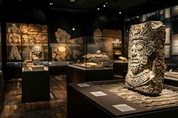
The Ancient Mayan Civilization
Who Were the Maya?The ancient Maya were a powerful civilization that lived in Central America. They built great cities and had an advanced culture. The Maya lived in what is now southern Mexico, Guatemala, Belize, and parts of Honduras and El Salvador. The Maya civilization began more than 3,000 years ago and reached its peak between AD 250 and 900. Mayan Cities and PyramidsThe Maya built amazing cities with large stone pyramids, palaces, and temples. Some famous cities include Tikal, Copán, and Chichén Itzá. In the center of each city was a great plaza for ceremonies. The Maya used huge stone
- 관리자 기자
- 2025-06-10 01:38
-

AI: The Technology That Thinks
Artificial Intelligence — or AI — is one of the most exciting and powerful technologies of our time. Once just an idea from science fiction, AI is now part of our daily lives, from smart assistants on our phones to self-driving cars. But what exactly is AI, and how is it changing the world? At its core, AI is about creating machines that can think, learn, and solve problems. Traditional computers follow fixed instructions, but AI systems can adapt. They use data to learn and make decisions. For example, when you stream music or shop online, AI recommends songs or products you might like, based
- 관리자 기자
- 2025-06-10 01:33
-
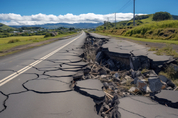
Earthquakes: When the Ground Shakes
What Is an Earthquake?An earthquake happens when the ground suddenly shakes. This shaking is caused by movements inside the Earth. The Earth’s surface is made of large pieces of rock called tectonic plates. These plates are always moving, but very slowly. Sometimes, the plates push against each other and get stuck. Over time, a lot of energy builds up. When the plates finally move, the energy is released as an earthquake. The ground can shake a little or a lot — depending on how much energy is released. How Do We Measure Earthquakes?Scientists use a tool called a seismograph to measure earthqu
- 관리자 기자
- 2025-06-10 01:25
-
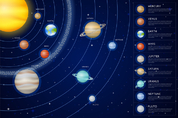
The Solar System
What Is the Solar System?The Solar System is made up of the Sun and everything that moves around it. The Sun is a giant ball of hot gas that gives us light and heat. Without it, life on Earth would not exist. Eight planets, many moons, asteroids, comets, and space dust all orbit the Sun. These objects are held in place by the Sun’s gravity. The Eight PlanetsThe planets are divided into two groups: Inner planets:Mercury, Venus, Earth, Mars→ They are rocky and smaller. Outer planets:Jupiter, Saturn, Uranus, Neptune→ They are gas giants (except Uranus and Neptune, which are called ice giants) and
- 관리자 기자
- 2025-06-10 01:21
-
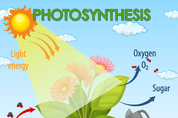
Photosynthesis: How Plants Make Their Own Food
[ Reading passage ] Photosynthesis is a chemical process that allows plants to create their own food. It mainly takes place in the chloroplasts of plant cells. Chloroplasts contain chlorophyll, the green pigment that absorbs sunlight. The basic equation of photosynthesis is:Carbon dioxide (CO₂) + Water (H₂O) + Sunlight → Glucose (C₆H₁₂O₆) + Oxygen (O₂) Let’s break it down:1️⃣ Water is absorbed from the soil through the plant’s roots.2️⃣ Carbon dioxide enters the plant through small openings in the leaves called stomata.3️⃣ Sunlight is captured by chlorophyll. Using energy from sunlight, the pl
- 관리자 기자
- 2025-06-10 01:16
-
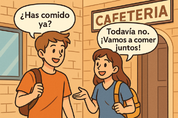
스페인어 기초 회화 2
【오늘의 대화 | Today's Dialogue】 A: ¿Has comido ya?(¿Has comido ya?)벌써 밥 먹었어요? B: Todavía no. ¡Vamos a comer juntos!(Todavía no. ¡Vamos a comer juntos!)아직 안 먹었어요. 우리 같이 먹어요! A: ¡Perfecto! ¡Vamos!(¡Perfecto! ¡Vamos!)완벽해요! 가요! 【키워드 | Keywords】 단어 발음 (Pronunciation) 뜻 ¿Has comido ya? 아스 꼬미도 야? 벌써 밥 먹었어요? Todavía no 또다비아 노 아직 아니에요 ¡Vamos a comer juntos! 바모스 아 꼬메르 훈또스 같이 밥 먹어요! ¡Perfecto! 뻴펙또 완벽해요! / 좋아요! ¡Vamos! 바모스 가요! / 출발해요! 【핵심 문구 해설 | Key Phrase Breakdown】 1️⃣ ¿Has comido ya? 벌써 밥 먹었어요? 친구, 동료에게 식사 여부를 자연스럽게 묻는 표현. 스페인어권에서는 인사처럼
- 관리자 기자
- 2025-06-10 00:20
-
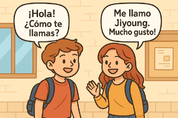
스페인어 기초 회화 1
【오늘의 대화 | Today's Dialogue】 A: ¡Hola! ¿Cómo te llamas?(Hola! ¿Cómo te llamas?)안녕하세요! 이름이 뭐예요? B: ¡Hola! Me llamo Minsu. ¿Y tú?(Hola! Me llamo Minsu. ¿Y tú?)안녕하세요! 저는 민수예요. 당신은요? A: Me llamo Jiyoung. ¡Mucho gusto!(Me llamo Jiyoung. ¡Mucho gusto!)저는 지영이에요. 만나서 반가워요! 【키워드 | Keywords】 단어 발음 (Pronunciation) 뜻 ¡Hola! 오라 안녕하세요! (Hello!) ¿Cómo te llamas? 꼬모 떼 야마스 이름이 뭐예요? (What’s your name?) Me llamo ~ 메 야모 ~ 제 이름은 ~입니다. (My name is ~.) ¿Y tú? 이 뚜 당신은요? (And you?) ¡Mucho gusto! 무쵸 구스토 만나서 반가워요! (Nice to meet you!) 【핵심 문구 해설 | Key Phrase B
- 관리자 기자
- 2025-06-10 00:15
-
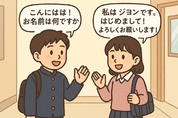
일본어 기초 회화 1
【오늘의 대화 | Today's Dialogue】 A: こんにちは!お名前は何ですか?(Konnichiwa! Onamae wa nan desu ka?)안녕하세요! 이름이 뭐예요? B: こんにちは!私は ミンス です。あなたは?(Konnichiwa! Watashi wa Minsu desu. Anata wa?)안녕하세요! 저는 민수예요. 당신은요? A: 私は ジヨン です。はじめまして!よろしくお願いします!(Watashi wa Jiyon desu. Hajimemashite! Yoroshiku onegaishimasu!)저는 지영이에요. 처음 뵙겠습니다! 잘 부탁드려요! 【키워드 | Keywords】 단어 뜻 こんにちは 안녕하세요 (낮 인사) お名前 (정중하게) 이름 何ですか 무엇입니까? 私 나, 저 あなた 당신 はじめまして 처음 뵙겠습니다 よろしくお願いします 잘 부탁드립니다 【핵심 문구 해설 | Key Phrase Breakdown】 1️⃣ お名前は何ですか? 직역: 이름은 무엇입니까? 정중하
- 관리자 기자
- 2025-06-10 00:05
-

중국어 기초 회화 2
【오늘의 대화 | Today's Dialogue】 A: 你吃饭了吗?(Nǐ chī fàn le ma?)밥 먹었어요? B: 吃了。你呢?(Chī le. Nǐ ne?)네, 먹었어요. 당신은요? A: 还没呢。我们一起去吃吧!(Hái méi ne. Wǒmen yìqǐ qù chī ba!)아직이요. 우리 같이 먹으러 가요! 【키워드 | Keywords】 단어 병음 (Pinyin) 뜻 吃饭 chī fàn 밥을 먹다 了吗 le ma ~했어요? (~했는지 묻는 표현) 吃了 chī le 먹었어요 你呢 Nǐ ne 당신은요? 还没 hái méi 아직 안 했어요 一起 yìqǐ 같이 去 qù 가다 吧 ba ~하자 (제안할 때 쓰는 표현) 【핵심 문구 해설 | Key Phrase Breakdown】 1️⃣ 你吃饭了吗? 직역: 너 밥 먹었어? 자연스러운 표현: 밥 먹었어요? 중국에서 인사처럼 자주 쓰는 표현이에요. 건강, 안부를 묻는 느낌으로 많이 사용해요. 2️⃣ 吃了。你呢? 네, 먹었어요. 당신은요?
- 관리자 기자
- 2025-06-09 23:56
-
 Entertainment · Broadcasting
Fair Play Menarini International Award, 29th Award Ceremony marked by waves of emotion
Entertainment · Broadcasting
Fair Play Menarini International Award, 29th Award Ceremony marked by waves of emotion
-
 Entertainment · Broadcasting
The Rose, the first Korean band to perform at Coachella, confirms Seoul concert on August 30 for “Once Upon a WRLD”
Entertainment · Broadcasting
The Rose, the first Korean band to perform at Coachella, confirms Seoul concert on August 30 for “Once Upon a WRLD”
-
 Culture · Events
Incheon Port Authority kicks off the 6th Incheon International Marine Forum in Songdo, Incheon, to look into the future of the global marine industry
Culture · Events
Incheon Port Authority kicks off the 6th Incheon International Marine Forum in Songdo, Incheon, to look into the future of the global marine industry
-
 Culture · Events
Seocho Symphony Orchestra to hold performances in Berlin, Germany, and London, England, commemorating the 80th anniversary of liberation and the 75th anniversary of the Korean War
Culture · Events
Seocho Symphony Orchestra to hold performances in Berlin, Germany, and London, England, commemorating the 80th anniversary of liberation and the 75th anniversary of the Korean War
-
 Culture · Events
Gyeonggi Province to hold its largest job fair for middle-aged and older workers on the 9th. 1,000 jobs to be filled.
Culture · Events
Gyeonggi Province to hold its largest job fair for middle-aged and older workers on the 9th. 1,000 jobs to be filled.
-
 International
Jeju's soul resonates in Rome... Singing of the pain and reconciliation of Jeju 4·3
International
Jeju's soul resonates in Rome... Singing of the pain and reconciliation of Jeju 4·3
-
 International
Seoul City establishes a foothold for K-Beauty and fashion to enter the European market, promoting Milan as a base
International
Seoul City establishes a foothold for K-Beauty and fashion to enter the European market, promoting Milan as a base
-
 Medical · Health
Korean Centers for Disease Control and Prevention: Increase in hand, foot, and mouth disease among infants and young children! Follow preventive measures and maintain good hygiene to stay healthy.
Medical · Health
Korean Centers for Disease Control and Prevention: Increase in hand, foot, and mouth disease among infants and young children! Follow preventive measures and maintain good hygiene to stay healthy.
-
 Medical · Health
Korean Centers for Disease Control and Prevention: Injured patients account for the largest proportion of hospitalized patients; falls are the main cause
Medical · Health
Korean Centers for Disease Control and Prevention: Injured patients account for the largest proportion of hospitalized patients; falls are the main cause
-
 Medical · Health
WHO and international health experts visit Wanju local food production sites
Medical · Health
WHO and international health experts visit Wanju local food production sites
-
2025-08-07 01:19
Lotte Scholarship Foundation Provides 300 Job Seekers with 300 Million Won in Scholarships and Employment Training Support
-
2025-08-01 09:42
Lotte Scholarship Foundation to Provide 270 Million Won in Scholarships to 100 Teenage Mentors
-
2025-07-09 11:08
Rethinking the Way We Handle the High School Credit System
-
2025-07-09 09:10
일본어 기초 회화 4
-
2025-07-09 09:06
일본어 기초 회화 3





















